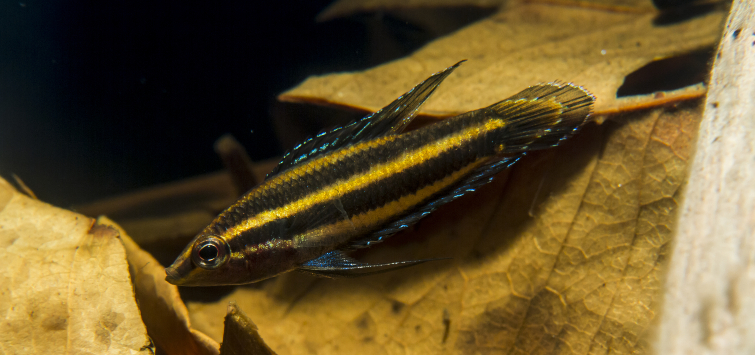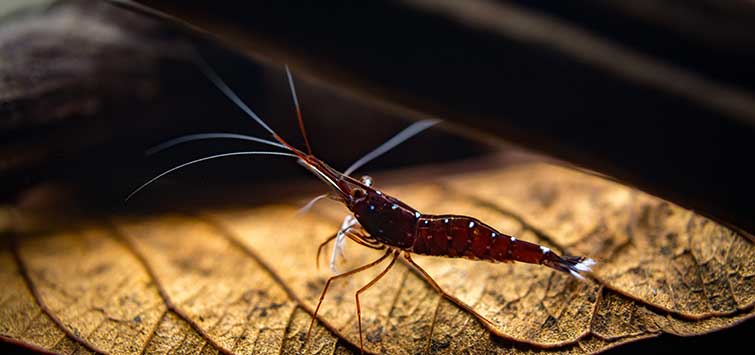A Small Leaf-Litter Aquarium for Licorice Gouramis
Joshua Wiegert
In a previous issue, we started our rounds of nano tanks, with setups ranging from a 1-gallon volcano shrimp tank to the largest of the batch, a 5-gallon leaf-litter setup for licorice gouramis. So far this year we’ve looked closer at each of them, focusing on one per issue, discussing changes to the nano tanks both natural and intentional, and now it’s time to revisit licorice gourami care.
First off, a small confession: I did not keep this tank running for the past year. I spent a good part of this year traveling or otherwise busy and found myself struggling to supply the licorice gourami with a steady supply of live food. So, when a friend of mine expressed interest in the tank, she found herself with an entire pico tank. But that just means we get to start over and demonstrate how to build an entirely new leaf-litter tank for licorice gouramis.
A Little About Leaf Litter
In the wild, you’ll find licorice gouramis in tropical forested streams and pools, choked with fallen leaves, branches, and the like, with a good amount of emergent vegetation. You’ll find this type of habitat all around the world, not just in Southeast Asia where our gouramis live. Chances are, you can drive to a similar habitat in your own climate zone without needing to stop for a soda (but I’ll still take one if you’re going in). And a huge number of fish (as well as other organisms) call this habitat home, not just gouramis. This habitat is everywhere, and it’s fantastic for fish—even obligatory for some species.
Many aquarists keep nano tanks for these types of fish with the addition of some dried leaves, typically from the Indian almond (Catappa) tree. The addition of “some” leaves to a tank doesn’t make it a leaf-litter tank, though. We’re going to be taking it a bit further and create a true leaf-litter tank where the leaves and other botanicals are the main part of the aquascape and integral to the tank. The term “botanicals” can be loosely applied to any mostly dried plant parts we’re adding to the tank, and includes not just leaves, but also bits of bark, seed and nut pods, and even driftwood.
While we’re going to focus on a pico tank, it’s worth noting that this idea scales upward just fine. You can set up a 10,000-gallon aquarium emulating the side of a pond beneath a big oak tree. The key for leaf-litter nano tanks is simply that the leaf litter should be the main focus of the ‘scape.
Enjoying TFH Magazine? Subscribe Today!
The Licorice Gouramis
Licorice gouramis are members of the genus Parosphromenus. There are about two dozen different species in the genus, 20 described and a bunch of others awaiting description. From a practical standpoint they’re pretty much all the same, and most of them even look a great deal alike: your standard gourami shape, a couple of dark lines running the length of the body, and a beautiful array of blues and reds in varying patterns, depending on species. The biggest of the licorice gouramis top out at about 2 inches (5 cm), with the smallest only reaching a max of about 1¼ inches (3 cm).
When you buy fish like these, it’s a real shot in the dark as to whether you’re getting the species you think, with a lot of sellers using random common names to describe multiple species, often just “licorice gourami.” Sometimes, you’ll get a word like “angel” or “strawberry” or even a specific name, like “linkei licorice gourami.” I’m not going to make many friends saying this, but those names are usually meaningless—at best, you’re getting some seller’s educated guess.
This is a bit of a danger because some of these species can and will hybridize. For that reason, you should absolutely get your licorice gouramis from a single source, all at once, and keep them that way. Your next batch might be the same species or a completely different one.
As well as being similar in appearance and size, licorice gouramis pretty much all need the same care. In the wild, you’re going to find them in litter-strewn swamps (that’s natural litter, not beer bottles and old shoes). They’ll need very soft water, as in negligible hardness, with an acid pH—ideally in the low 5.0s, which is below the usual “acidic” range for aquariums, though some species may tolerate a pH of 6.0 to 6.5, especially if the fish are captive-raised. While water flow should be minimal, we don’t want to emulate a stagnant, smelly swamp too closely. Drop a small airstone in the tank so it just bubbles.
One of the more interesting effects of this low pH is that it inhibits much bacterial growth, which includes the nitrifying bacteria that support biological filtration. So water changes and plants are going to be your nutrient uptake methods: If you’re running at the higher end of the pH range, toss a sponge filter on the end of your airstone, or do it if it’ll make you feel better, but you don’t need it. Stock and feed lightly, and use plants.
But this leads to a problem: While we think of swampy areas as rife with plants, there’s not a lot of them growing underwater. And our licorice gouramis like it dark, which is not conducive to vigorous plant growth. So, we’re not going to be adding much in the way of submerged aquatic plants. Instead, this is one of those cases where duckweed is your friend. Try other floaters, too: water sprite, Azolla, even a water hyacinth. Many emergent plants will also thrive with this water, with their roots pulling nutrients out of the tank—try a bit of monstera, pothos, or even a bit of basil.

Setting It Up
I started with a standard 2.5-gallon (about 10-liter) tank, and spraypainted the sides, back, and bottom black. Next, I tossed in a few handfuls of dark black sand. (Remember, we’re going for dark.)
Then I added a couple pieces of mopani wood. Mopani is a reasonably dense wood that tends to either be neutrally buoyant or sink right away. I left one piece sticking out of the top of the tank, and wrapped a monstera cutting around it, leaving the roots dangling in the water.
Now it’s time to add the leaf litter! Lots of different plants release tannins, and are excellent for aquariums. As mentioned, Catappa is a classic one, as are oak and magnolia. I prefer not to risk collecting my own, and instead just bought an assortment, getting a handful of banana leaf pieces, palm fronds, and two sizes of Catappa leaves. The banana leaf pieces are rectangular: I like to roll these up and tuck them in places, which provide a neat little “curled leaf” for fish to hide in. I also like to top the entire thing with a couple of large leaves—I just think they look neat.
The tank was then filled with a mixture of about 75 percent RO water and 25 percent my reasonably soft tap water. I added a small airstone, and a little pico tank heater, as I didn’t want these guys getting chilled.
Then it was time to add the fish. Here is an odd case where you don’t want to let the tank “sit” for a few days between setup and adding the fish. Most times, they’re coming from a sterile wholesaler or retailer tank, and they’re used to “normal” conditions. Plunk them in an aged, soft acidic leaf litter tank and they’ll be floating the next morning.
This is because the botanicals are going to slowly decay and release tannins into the tank. Within a couple of days, your nice clear tank is going to turn yellow, and eventually brown. Keep an eye on the darkness level, and if it gets too much, do a water change. Monitor your pH, and don’t let it get too acidic.
Once the fish were acclimated, into the tank they went. I added six of them, which is way too many fish for a tank this size. Ultimately, my plan is to watch them and see who pairs off, and as they do so, remove the single ones.
As I initially mentioned, feeding these guys can be a challenge. They’ve got small mouths, and they’re picky. Mosquito larvae make great food, as do small daphnia varieties, like Moina, Ceriodaphnia, and the like.
Beware that the acid conditions of your tank may kill your daphnia, so feed sparingly. Unfortunately, that does mean that the trick of “add a whole lot of daphnia before you go out of town” won’t work, not to mention overpower the bioload of the tank.

If you’re the adventurous sort, remember that I said you probably live near a habitat like this. While most of our cultivated live foods do not do well under these conditions, there are small zooplankton species that do, and you could collect some and try to culture it yourself; cladocerans like Scapholeberis, Bosmina, and a few others can be found, and I don’t imagine culture would be that different.
You can also culture baby brine shrimp, though be sure they’re well washed before adding. Vinegar eels are also an easy food, and they tend to handle the pH until they starve. Additionally, small surface foods may be taken, provided they’re live and motile; I found smaller fruit flies worked. If you’re very, very lucky, you might find they take frozen food, but don’t count on it.
Breeding licorice gouramis is, surprisingly, not a challenge once you manage to get them fed. Males are far more colorful than females. They’ll create a little territory around a cave of some sort. I like to use seedpods from a wood apple, Limonia, which is kind of like a miniature coconut (though, beware that some types of wood apple are quite large, closer to size to an actual apple, and won’t work). The folded banana leaves also work, though they’re less durable.
The pair will spawn inside the cave. Some reports have the male building a bubblenest inside, but I’ve never seen this. Some Betta species do build a bubblenest in caves, so it isn’t far-fetched. I’m not sure if differing reports indicate different species, or if the licorice gouramis just sometimes build the nest.
The pair will generally raise the fry without issue, though you’ll need small live food (such as infusoria) to rear them. Note that if other adult licorice gouramis are present, they will eat the juveniles.
A Taste for Licorice
Licorice gourami care isn’t for beginners. These fish demand soft, acidic water, live food, dim lighting, and a carefully constructed environment that most aquarists would call a “detritus-filled swamp.” But meet their requirements, and they reveal behaviors and colors that rival much larger or flashier species—plus, they might even breed for you.
A pair can live comfortably in a pico-sized setup, though larger tanks offer room to explore more complex dynamics. The leaf-litter tank for them isn’t just a stylistic choice—it’s a functional ecosystem, modeled on real habitats where these fish evolved to thrive. It might not impress fans of spotless glass and plastic castles, but for those who appreciate nuance, biology, and a bit of decay, it’s one of the most rewarding aquascapes you can build. They may not be for everyone—they’re challenging, subtle, and a little obscure—but if you develop a taste for licorice gouramis, you’ll find them unforgettable.

.png?h=595&iar=0&w=2781&hash=5FD5E69473BCC22199FBFA2FB71B6033)




